Gulai
Gulai is a type of food containing rich, spicy and succulent curry-like sauce commonly found in Indonesia,[4] Malaysia and Singapore. The main ingredients of this dish are usually poultry, goat meat, beef, mutton, various kinds of offal, fish and seafood, as well as vegetables such as cassava leaves, unripe jackfruit and banana stem.
 A plate of chicken gulai. | |
| Course | Main |
|---|---|
| Place of origin | Indonesia[1][2][3][4][5] |
| Region or state | Sumatra[5] |
| Associated national cuisine | Indonesia,[1] Malaysia,[6][7] Singapore, Brunei, and Southern Thailand |
| Serving temperature | Hot and room temperature |
Gulai is often described as Indonesian curry,[8][2][9][10] although it is also considered a local dish in Malaysia and Singapore. Gulai is a common name to refer to curry dishes in the country,[1] although Indonesian, Malaysian, and Singaporean cuisine also recognise kari (curry).
Ingredients

The gulai sauces commonly have a thick consistency with a yellowish colour because of the addition of ground turmeric. Gulai sauce ingredients consist of rich spices such as turmeric, coriander, black pepper, galangal, ginger, chilli pepper, shallot, garlic, fennel, lemongrass, cinnamon and caraway, ground into paste and cooked in coconut milk with the main ingredients.[4][11] In Malaysia, Kerisik is also added to thicken the gravy. [12]
Gulai recipes and ingredients are slightly different across the archipelago. For example the colour of gulai in Java is mostly light yellow, while in Sumatra, it has a more reddish tone. In Palembang, the gulai composes of ingredients such as garlic, shallot, turmeric, turmeric leaf and pineapple. In Minangkabau lands of West Sumatra, the ruku-ruku leaf (Ocimum tenuiflorum) is a must-use ingredient, while in its Javanese counterpart, the corriander is favoured. Another difference is that tamarind is often added in Javanese gulai, giving it a slightly sourer taste than other versions of gulai.[13]
History
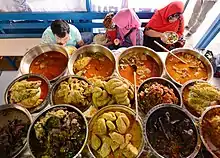
Gulai originated on the island of Sumatra,[1] Indonesia and is thought to be a local adaptation of Indian curry, having developed and derived from Indian influence on Southeast Asia. The dish is widely served in the Malay Archipelago, especially in Sumatra, the Malay Peninsula, Java and Borneo. The thick and yellowish gulai sauce is one of the most common sauces found in Minangkabau cuisine, used to give a rich and spicy taste to meats, fish, and vegetables. Gulai is often described as succulent and spicy, yet subtly combining flavours of different spices into one suave and smooth taste which makes it difficult to figure out the individual spices used.[14]
The ingredients are simmered and slowly cooked in coconut milk, a mixture of spices and chili pepper. The thick golden, yellowish, succulent and spicy gulai sauce has become a hallmark that can be seen on window displays of restaurant establishments in Padang, Indonesia. In Padang, smart cooking means being capable of preparing gulai. Rendang (beef simmered in coconut milk and spices), asam padeh (sour and spicy stew) and kalio (watery and light-coloured gravy) are often considered as variations of Padang gulai.[15]
In Malaysia, Asam Pedas, a popular Malay sour fish soup is sometimes called gulai tumis. In Perak and Pahang, gulai tempoyak, a local specialty is commonly served as a daily meal and a meal for festive celebrations such as Hari Raya and wedding ceremonies. [16] In some restaurants, roti canai (which is usually servered with curry) might also be served with gulai.
The gulai sauce found in Minangkabau, Acehnese, and Malay cuisine usually has a thicker consistency than the gulai sauce found in Java which is thinner, served in soup-like dishes containing pieces of mutton, beef or offal.[4][3] Gulai is usually served with steamed rice.
Variations
Gulai recipes can be found in various cooking traditions across the Malay Archipelago; such as Minangkabau, Malay, Acehnese and Javanese cuisine. However, gulai recipes show exceptional diversity in West Sumatra.[17] Some variations of gulai include:
|
Poultry
Meat
Insect
Offal
|
Fish and sea food
Vegetable
|
Gallery
- Gulai variants
 Gulai kambing, goat gulai, a Padang food
Gulai kambing, goat gulai, a Padang food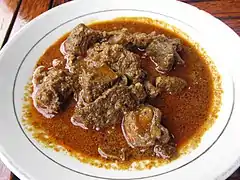 Gulai cancang, chopped meat gulai, a Padang food
Gulai cancang, chopped meat gulai, a Padang food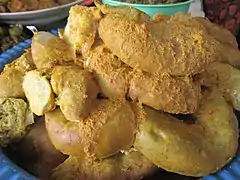 Gulai tambunsu, intestine gulai sold in Bukittinggi
Gulai tambunsu, intestine gulai sold in Bukittinggi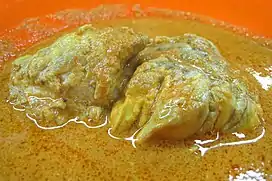 Gulai banak or gulai otak, brain gulai, a nasi kapau dish
Gulai banak or gulai otak, brain gulai, a nasi kapau dish Gulai limpo, cow's spleen gulai, a Minangkabau dish
Gulai limpo, cow's spleen gulai, a Minangkabau dish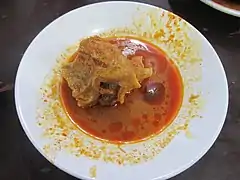 Gulai gajeboh, cow's hump fat gulai, specialty of Kapau, West Sumatra
Gulai gajeboh, cow's hump fat gulai, specialty of Kapau, West Sumatra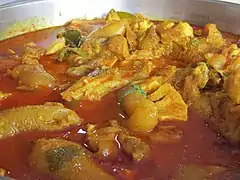 Gulai tunjang, cow's trotters gulai, sold in Bukittinggi
Gulai tunjang, cow's trotters gulai, sold in Bukittinggi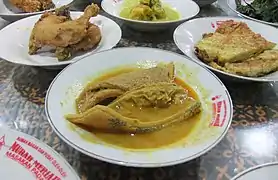 Gulai babat, tripes gulai, a Padang food
Gulai babat, tripes gulai, a Padang food Gulai kerapu, grouper gulai, a Padang Pariaman food
Gulai kerapu, grouper gulai, a Padang Pariaman food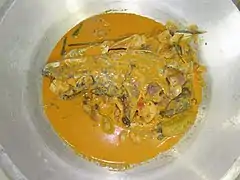 Gulai kapalo lauak, fish head gulai, a Minang dish
Gulai kapalo lauak, fish head gulai, a Minang dish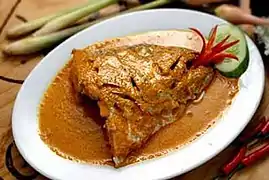 Gulai kepala ikan, fish head gulai, an Aceh version
Gulai kepala ikan, fish head gulai, an Aceh version Gulai sotong, squid gulai
Gulai sotong, squid gulai Gulai udang, shrimp gulai, a Padang dish
Gulai udang, shrimp gulai, a Padang dish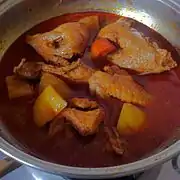 Gulai ayam, this one is a Javanese version chicken gulai
Gulai ayam, this one is a Javanese version chicken gulai.JPG.webp) Gulai cubadak, unripe jackfruit gulai
Gulai cubadak, unripe jackfruit gulai Gulai jariang, jengkol gulai, a Padang food
Gulai jariang, jengkol gulai, a Padang food
 Gulai sukun, breadfruit gulai
Gulai sukun, breadfruit gulai
See also
References
- "40 Indonesian foods we can't live without". CNN. 25 February 2016. Retrieved 23 July 2018.
- Hunt, Kristin (16 March 2014). "A beginner's guide to the curries of the world". Thrillist. Retrieved 23 July 2018.
- "Gulai" (in Indonesian). Tribunnewswiki. 9 July 2019. Retrieved 7 October 2020.
- "Sejarah Asal Mula Masakan Bersantan" (in Indonesian). Republika. 16 July 2015. Retrieved 7 October 2020.
- "Sejarah dan Jenis-jenis Gulai yang Khas di Indonesia" (in Indonesian). Kumparan. 15 January 2019. Retrieved 16 October 2020.
- https://www.researchgate.net/publication/320897695_Past_and_Present_Practices_of_the_Malay_Food_Heritage_and_Culture_in_Malaysia
- https://core.ac.uk/download/pdf/82136975.pdf
- "Gulai, Traditional Stew From Sumatra". Taste Atlas. Retrieved 12 October 2020.
- Lilly T. Erwin. "Aroma Rasa Kuliner Indonesia: Sajian Gulai (Indonesian Culinary: Gulai (Curry))". Gramedia International. Archived from the original on 25 April 2012. Retrieved 31 May 2014.
- "Padang-Style Chicken Curry (Gulai Ayam)". SAVEUR. Retrieved 23 July 2018.
- "Resep Gulai Ayam" (in Indonesian). Resep Masakan Indonesia. Retrieved 31 May 2014.
- https://www.rasa.my/resipi-gulai-ayam-sedap-mesti-naik-selera/
- Pertiwi, Ni Luh Made. "Apa Bedanya Gulai Jawa dengan Gulai Sumatera?". KOMPAS.com (in Indonesian). Retrieved 12 October 2020.
- Tan, Christopher (24 February 2014). "Spice World". SAVEUR. Retrieved 23 July 2018.
- Donny Syofyan (24 November 2013). "By the way ... I just can't live without Padang food". The Jakarta Post.
- https://core.ac.uk/download/pdf/82136975.pdf
- "Mengapa Makanan Khas Minangkabau Banyak Menggunakan Santan?". kumparan (in Indonesian). Retrieved 12 October 2020.
- "Resepi Gulai Telur Itik" (in Malay). MyResipi. Archived from the original on 31 May 2014. Retrieved 31 May 2014.
- "Gulai Kambing" (in Indonesian). Kompas.com. 17 August 2008. Retrieved 31 May 2014.
- https://docs.google.com/viewerng/viewer?url=http://malaycivilization.com.my/omeka/files/original/4e675c45b3587aabf71415dcb28d9f16.pdf
- Kompas Cyber Media (24 May 2016). "Gulai Gajebo, "Makanan Surga" dari Ranah Minang". KOMPAS.com (in Indonesian). Retrieved 23 July 2018.
- "Gourmet or Garbage?". My Cooking Without Borders. 22 September 2011. Retrieved 23 July 2018.
- Kompas Cyber Media (19 October 2009). "Gulai Kepala Ikan". KOMPAS.com (in Indonesian). Retrieved 23 July 2018.
- https://www.malaymail.com/news/life/2020/08/26/kedahan-home-cook-azah-johari-starts-youtube-channel-to-revive-traditional/1897249
- https://rasamalaysia.com/gulai-tumis-tamarind-fish-curry/
- https://www.nst.com.my/lifestyle/jom/2019/08/516665/jom-go-taste-kampung-life
- "Gulai Nangka (Indonesian Unripe Jackfruit Curry)". pimentious.com. Retrieved 23 July 2018.
- Setiawati, Odilia Winneke. "Resep Sahur : Gulai Daun Singkong Tumbuk". detikfood (in Indonesian). Retrieved 23 July 2018.
External links
- Red snapper's head gulai recipe (in Indonesian)
- Goat meat gulai recipe (in Indonesian)
